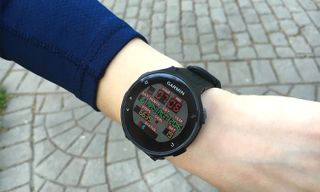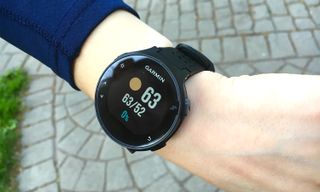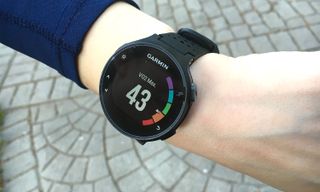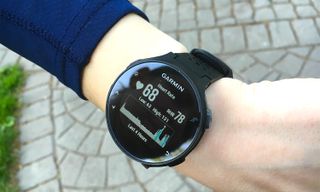Garmin Forerunner 235: The Best Running Watch Yet
Thanks to its fast GPS, accurate heart-rate monitoring, and thin and light design, the Garmin Forerunner 235 is the best GPS running watch for the money.
Why you can trust Tom's Guide

The Garmin Forerunner 235 ($329) takes everything that was great about its predecessor, the Forerunner 225, and packs it into a smaller and lighter package. It also adds new features, such as the ability to add third-party watch faces and apps. I spent a week using the Forerunner 235 as both a running watch and an all-day activity tracker, and can confidently say this is the best GPS watch I've used. The Forerunner 235 isn't cheap, but if you're serious about running and want a great wrist-worn partner, this is the best fitness tracker for runners.
Editor's note, Nov. 20: Best Buy is offering a killer Black Friday deal on several Garmin watches, including the Forerunner 235. Our favorite running watch will be discounted to $199.99 (down from $249.99) starting Thurs., Nov. 22.
Design

While it definitely has a sporty design, the Forerunner 235 looks less like a GPS watch and more like a traditional timepiece, especially when you change its face. I tested an all-black version, but if you want yours to stand out, you can get it with a frost-blue or red band.
At 1.77 inches in diameter, 0.46 inches thick and 1.5 ounces, the Forerunner 235 is thinner and lighter than its predecessor, the Forerunner 225 (1.9 x 1.3 x 0.6 inches and 1.9 ounces). Plus, Garmin has increased the size of the display to 1.23 inches on the 235 (up from 1 inch on the 225) and boosted the resolution slightly, to 215 x 180 pixels. The screen is no longer a perfect circle — the top and bottom are sliced off — but overall, it's larger.

The thinness and lightness of the Forerunner 235 were immediately apparent. As soon as I strapped it onto my wrist, it felt like it was barely there. As on its previous watches, Garmin placed two buttons on the right side of the watch (start and back), and three on the left (backlight, up and down). Using those buttons along with an intuitive on-screen interface, I easily navigated through the 235's menus. There's no need for a touch screen; I've found that touch screens don't work well when my hands get sweaty.
Although it doesn't track swimming, the Forerunner 235 is waterproof to depths of up to 165 feet.
MORE: Best Fitness Trackers
Display
The Forerunner 235's display was not the most colorful I've seen, but it was easy to read in all but the dimmest light, and in those circumstances, its handy backlight provided all the illumination I needed. It was very easy to read outdoors, especially in bright sunlight, thanks to its transflective display.

Colors aren't as vivid as you'd get with bona fide smartwatches, such as the Moto 360 Sport, but I'll gladly trade a little dullness for the increased functionality of Garmin's watch.
Features
The Forerunner 235 boasts some great advanced running features. These include some previously found only on Garmin's higher-end GPS watches, such as your VO2 max, a gauge of how much oxygen your body can process. The higher the number, the more fit you are.
The Forerunner 235 also has a recovery advisor, which lets you know how long you should rest before your next strenuous activity.

Similar to the Garmin vivoactive HR, the Garmin Forerunner 235 is about as close as a fitness gadget gets to being a true smartwatch. You can receive text and call notifications from your smartphone but can't reply unless you're using an Android device. From the watch, you can also control music from your phone, regardless of whether it's Android or iOS.
The thinness and lightness of the Forerunner 235 were apparent as soon as I strapped it on. It felt like it was barely there.
Garmin has a proto app store called Connect IQ, where you can find a hundred or so watch faces, apps and widgets to download to the Forerunner 235. Most merely take the information gathered by the watch and present it in different ways, but there are a few fun ones, such as a watch face that looks like the flux capacitor's digital readout from Back to the Future.
Performance
When I first started testing GPS watches, I could usually get most of my stretching done by the time the device finally acquired a satellite signal. No longer. The Forerunner 235 picked up a GPS signal faster than any device I've ever tested. The watch chirped, indicating it was connected, in less than 20 seconds. It looks for both GPS and GLONASS (Russia's version of GPS) satellites, which requires a little more power from the watch, but you can change this option.
MORE: How to Choose the Right Fitness Tracker for Your Needs
I took the Forerunner 235 out for several runs over the course of a week, and found its GPS and heart-rate monitor were both spot-on. On occasion, the watch would bump up against the limits of its processor. When I would switch away, or back to, a custom watch face, the Forerunner 235 would stutter for about half a second.
VO2 Max and Recovery Advisor

Just how fit are you? There are so many different metrics, but one that's particularly helpful for runners is their VO2 max score, which reflects the body's ability to process oxygen. To calculate it, you divide the amount of oxygen you absorb per minute by your body weight. The Forerunner 235 determines the oxygen flow by using the optical heart-rate monitor. The higher the number, the better. A typical individual will have a VO2 max score in the 40s; mine was 43.
Previously only found on its higher-end GPS watches, the Forerunner 235 calculates your VO2 max, a gauge of how much oxygen your body can process.
I used the Forerunner's Recovery Advisor as just that — advice. After three days of running 4 miles a day, the Recovery Advisor said that my recovery time would be three days. I took one day off and then cranked out 5 more miles.
App
Garmin may be trying to cram a bit too much into its Connect app.

Along the bottom of the black interface are five icons: Snapshot, Leaderboard, Calendar, News Feed, and More. Snapshot provides a look at your day, showing your steps and sleep at the top, active calories, intensity minutes and floors climbed. There's even a large area where you can see if MyFitnessPal is connected, but it's a waste of screen space. Swiping right or left shows you more detail about steps, sleep, running activities, weight, intensity minutes, community and even your last golf round. (Fortunately, you can customize which screens show up.)
MORE: Which Fitness Tracker to Use For Each Sport
In the Leaderboard section, you can compete with friends to see who's taken the most steps, while Calendar lets you view your fitness activities in a calendar view. News Feed shows your activities arranged in a list, but this was the least interesting view and felt redundant.

Clicking on the More icon brings up a huge menu where you can, again, dig deeper into stats for various activities, workouts and your connected devices. Here, you can connect to Garmin's Connect IQ store to download apps, widgets and golf courses to the Forerunner 235.

I like that Garmin presented all of my fitness data in many different ways, but it's too much. It's very easy to get lost in the various submenus. I also found that the app wouldn't always sync automatically. Even though it was connected to the watch via Bluetooth, I sometimes had to "wake" the connection by pressing a button on the Forerunner 235.
Battery Life
Garmin says the Forerunner 235 will last 11 hours on a charge in Training Mode (using GPS and the heart-rate monitor) and up to nine days when it's being used as a watch with activity tracking, notifications and the heart rate monitor.
The Forerunner 235 picked up a GPS signal faster than any device I've ever tested.
I strapped the fully charged watch onto my wrist on a Monday. I wore the watch continuously for an entire week, used its GPS for about 2 and a half hours during the week and took it off only when I went to sleep. By the following Monday, it still had 20 percent battery life remaining.
I especially like that Garmin continues to shrink the size of its charging connectors. Although it's still proprietary, the small clip hooks securely onto the side of the Forerunner 235, and charges it quickly via USB.
Bottom Line
Moderate to active runners will love what the Forerunner 235 has to offer. It's thin, light and easy to use; accurately tracks your location and heart rate while you're running; and lets you customize its display. The only feature it lacks that I wish it had is the ability to load and play music from the watch itself, as you can do on the TomTom Spark Cardio + Music.
If you want to save $50, consider the Garmin Forerunner 230, which has all of the same features as the 235 but lacks a built-in heart-rate monitor. Consequently, it will last up to 16 hours in Training Mode, compared with the Forerunner 235's 11 hours.
People looking for an all-purpose GPS watch would be better off getting the Garmin vivoactive HR, which tracks a wider range of activities, from golf to paddleboarding. But runners looking for the best all-around GPS watch will be thoroughly satisfied with the Forerunner 235. I know I am.
Sign up to get the BEST of Tom's Guide direct to your inbox.
Here at Tom’s Guide our expert editors are committed to bringing you the best news, reviews and guides to help you stay informed and ahead of the curve!

Michael A. Prospero is the U.S. Editor-in-Chief for Tom’s Guide. He oversees all evergreen content and oversees the Homes, Smart Home, and Fitness/Wearables categories for the site. In his spare time, he also tests out the latest drones, electric scooters, and smart home gadgets, such as video doorbells. Before his tenure at Tom's Guide, he was the Reviews Editor for Laptop Magazine, a reporter at Fast Company, the Times of Trenton, and, many eons back, an intern at George magazine. He received his undergraduate degree from Boston College, where he worked on the campus newspaper The Heights, and then attended the Columbia University school of Journalism. When he’s not testing out the latest running watch, electric scooter, or skiing or training for a marathon, he’s probably using the latest sous vide machine, smoker, or pizza oven, to the delight — or chagrin — of his family.